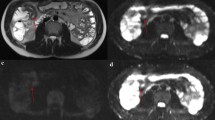Abstract
Purpose
To compare histopathology with ADC values in strictured bowel segments in pediatric patients with known Crohn’s disease and surgical bowel resection.
Methods
Magnetic resonance enterography (MRE) images of 14 subjects with Crohn’s disease who had surgical bowel resection for strictures were retrospectively reviewed. Five of 14 subjects had DWI (b=0, 500, 1000) sequences included in the MRE study. ADC measurements were made by placing ROI’s in the strictured bowel wall and compared to full-thickness histologic analysis of resected specimens. ADC values were also compared to control ADC measurements (in normal and inflamed-nonstenotic bowel segments) as well as the mean ADC values of Crohn’s patients published in the literature.
Results
All five subjects had transmural fibrosis. The mean ADC value with b = 500 was 0.92 ± 0.10 × 10−3 mm2/s and with b = 1000 was 0.8 ± 0.05 × 10−3 mm2/s. There was a significant difference in ADC values between strictures and inflamed-nonstenotic segments (p=0.0143) and between normal and diseased bowel segments (p=0.009–0.0143).
Conclusions
Quantitative ADC measures of transmural fibrosis are lower compared to the reported values of inflammation in Crohn’s disease. To our knowledge, this is the first pediatric pilot study to investigate the correlation of quantitative DWI with histology of surgical specimens in pediatric patients with Crohn’s disease. Our results are comparable to a recently published study in adult Crohn’s patients showing a significant correlation between a decrease in ADC values and fibrosis



Similar content being viewed by others
References
Rieder F, Zimmermann EM, Remzi FH, Sandborn WJ (2013) Crohn’s disease complicated by strictures: a systematic review. Gut 62:1072–1084
Quencer KB, Nimkin K, Mino-Kenudson M, Gee MS (2013) Detecting active inflammation and fibrosis in pediatric Crohn’s disease: prospective evaluation of MR-E and CT-E. Abdom Imaging 38:705–713
Ream JM, et al. (2013) MRI diffusion-weighted imaging (DWI) in pediatric small bowel Crohn disease: correlation with MRI findings of active bowel wall inflammation. Pediatr Radiol 43:1077–1085
Oto A Active, et al. (2011) Crohn’s disease in the small bowel: evaluation by diffusion weighted imaging and quantitative dynamic contrast enhanced MR imaging. J Magn Reson Imaging 33:615–624
Kiryu S, et al. (2009) Free-breathing diffusion-weighted imaging for the assessment of inflammatory activity in Crohn’s disease. J Magn Reson Imaging 29:880–886
Adler J, et al. (2011) Magnetization transfer helps detect intestinal fibrosis in an animal model of Crohn disease. Radiology 259:127–135
Dillman JR, et al. (2013) US elastography-derived shear wave velocity helps distinguish acutely inflamed from fibrotic bowel in a Crohn disease animal model. Radiology 267:757–766
Stidham RW, et al. (2011) Ultrasound elasticity imaging for detecting intestinal fibrosis and inflammation in rats and humans with Crohn’s disease. Gastroenterology 141:819–826.e1
AlHawary M, Zimmermann EM (2012) A new look at Crohn’s disease: novel imaging techniques. Curr Opin Gastroenterol 28:334–340
Punwani S, et al. (2009) Mural inflammation in Crohn disease: location-matched histologic validation of MR imaging features. Radiology 252:712–720
Zappa M, et al. (2011) Which magnetic resonance imaging findings accurately evaluate inflammation in small bowel Crohn’s disease? A retrospective comparison with surgical pathologic analysis. Inflamm Bowel Dis 17:984–993
Ziech ML, et al. (2011) Retrospective comparison of magnetic resonance imaging features and histopathology in Crohn’s disease patients. Eur J Radiol 80:299–305
Tielbeek JAW, et al. (2013) Evaluation of conventional, dynamic contrast enhanced and diffusion weighted MRI for quantitative Crohn’s disease assessment with histopathology of surgical specimens. Eur Radiol. doi:10.1007/s00330-013-3015-7
Girometti, R. et al. MRI scoring system including dynamic motility evaluation in assessing the activity of Crohn’s disease of the terminal ileum (2008) Acad Radiol 15:153–164
Rimola J, et al. (2009) Magnetic resonance for assessment of disease activity and severity in ileocolonic Crohn’s disease. Gut 58:1113–1120
Do RKG, et al. (2010) Diagnosis of liver fibrosis and cirrhosis with diffusion-weighted imaging: value of normalized apparent diffusion coefficient using the spleen as reference organ. AJR Am J Roentgenol 195:671–676
Freiman M, et al. (2012) In vivo assessment of optimal b-value range for perfusion-insensitive apparent diffusion coefficient imaging. Med Phys 39:4832
Freiman M, et al. (2013) Characterization of fast and slow diffusion from diffusion-weighted MRI of pediatric Crohn’s disease. J Magn Reson Imaging 37:156–163
Vernier-Massouille G, et al. (2008) Natural history of pediatric Crohn’s disease: a population-based cohort study. Gastroenterology 135:1106–1113
Author information
Authors and Affiliations
Corresponding author
Rights and permissions
About this article
Cite this article
Kovanlikaya, A., Beneck, D., Rose, M. et al. Quantitative apparent diffusion coefficient (ADC) values as an imaging biomarker for fibrosis in pediatric Crohn’s disease: preliminary experience. Abdom Imaging 40, 1068–1074 (2015). https://doi.org/10.1007/s00261-014-0247-1
Published:
Issue Date:
DOI: https://doi.org/10.1007/s00261-014-0247-1




